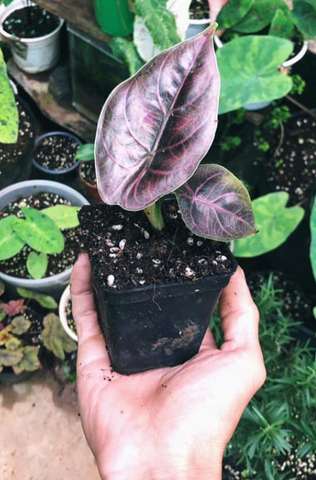Basic Information
Discover Alocasia Azlanii – a tropical jewel from Borneo. Its metallic purple leaves and adaptability as a houseplant make it a unique addition to indoor spaces. Our guide helps you care for and maintain its vibrant beauty, ensuring it remains a stunning feature in your home.



Light
Alocasia Azlanii thrives in bright, indirect light. Direct sunlight can damage its leaves, so place it near east or west-facing windows for filtered light. If using artificial lighting, position a full-spectrum LED about a foot away for optimal growth. The right amount of light is crucial for maintaining its vivid leaf coloration and promoting healthy growth.
Water
Striking a balance in watering is key for Alocasia Azlanii. Allow the top few inches of soil to dry out before watering again, and reduce watering in winter during dormancy. Overwatering can cause root rot while underwatering leads to drooping leaves. Regularly check soil moisture to provide just the right amount of water.
Soil
For the healthy growth of Alocasia Azlanii, it is crucial to use well-draining and aerated potting soil. It is recommended to mix coconut husk, perlite, and potting soil. The soil should contain some moisture, but it should also drain any excess water effectively. If the soil fails to drain correctly or retains water excessively, it is necessary to adjust the soil composition.
Temperature
Alocasia Azlanii prefers a temperature range of 65 to 75ºF (18 to 24ºC). Protect it from cold drafts and sudden temperature changes, which can stress the plant. Maintaining a consistent temperature is important, especially during colder months.
Humidity
High humidity, around 60% or more, is ideal for Alocasia Azlanii. Low humidity can cause brown leaf edges. Increase humidity with a humidifier, misting, or a pebble tray. These methods help create a humid environment akin to its natural tropical habitat.
Fertilizer
During spring and summer, fertilize monthly with a half-strength balanced liquid fertilizer. Avoid over-fertilizing, especially in winter when the plant’s growth slows down.
Growth Rate
Alocasia Azlanii typically reaches about 2 feet in height. It’s a moderate grower, producing new leaves under optimal conditions. Growth slows during dormancy in colder months.
Pet Safety
This plant is toxic to pets and humans due to calcium oxalate crystals. Keep it out of reach to prevent accidental ingestion.
Grow in Semi-Hydro
- Alocasia plants excel in Semi-hydroponics (LECA/Pon) due to their natural inclination for root growth and humidity.
- Successfully transitioning Alocasia to Semi-hydroponics is enhanced with a Nutrient Stagnant Wicking (NSW) setup.
- Alocasia roots adapt seamlessly to the water in LECA/Pon, with quick resolution of any root hair issues in NSW setups.
- Fertilizer includes a nutrient mix concentration of approximately 800-1000ppm.
- These plants are versatile in different temperature and humidity settings, thriving in controlled environments.
- Long-term care involves maintaining a constant water reservoir and performing occasional system flushes for sustained growth.
Tips
- Rotate the plant for uniform light exposure.
- Regularly check for and treat pests like spider mites or aphids.
- Repot every couple of years to refresh soil and encourage growth.
- Keep the plant away from drafty areas to maintain a stable temperature.
Happy planting! 🌱


